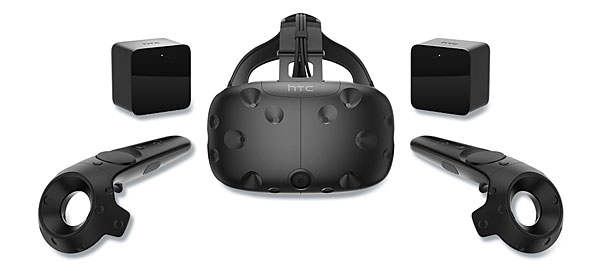...3D TV is a failure because the majority of people do not like wearing the glasses, yet VR is the NEXT BIG THING since people will just looooove wearing a portable refrigerator on their heads.
Virtual Reality Is Here Page 2

The tracking in the headset is multi-part and clever. Accelerometers, gyros, and, in the case of the Rift, magnetometers track the motions of your head in three axes (up/down, left/right, tilted). These motion sensors have gotten really good, thanks to the ubiquity of smartphones.
The sensors aren’t nearly enough to simulate normal movement, though. The Rift and the Vive are two-part systems. A separate IR camera bundled with the Rift tracks your head’s position by seeing small IR emitters arrayed on the front and back of the headset. This adds precision, and it lets you move vertically and horizontally. Peer over a virtual ledge, or peek around a doorway. The Vive goes one step further, literally, tracking you with lasers as you move around a defined space (see “Beyond Rift”).

The sonics aren’t as revolutionary as the visuals, only because we’ve had positional audio in games for nearly two decades. Suffice it to say, VR’s audio will track your position and direction just like the video. The Rift has headphones built in; the Vive comes with earbuds in the box.
OK, so you can look and move around an environment. Not quite a holodeck, but really close (and it’s not even the 24th century yet). But what about interacting with the environment? Yeah, you can do that, too.
The Vive and (by the time you read this) the Rift have hand controllers that are also tracked. Move your hands, and your VR hands move, too. I haven’t used the Vive’s controllers, but I have tried the Rift’s Touch controllers. They’re almost as mind-blowing as the visuals. They look like the top part of a joystick and strap to your hands. Not only are your hands tracked, but your individual fingers are tracked. Look down in a game and wiggle your fingers, and your virtual fingers will wiggle. Reach down and pick something up by physically reaching down and closing your hand around the object. Sure, in the real world, you’re just gripping the controller—but in the game, you’re picking up a crowbar. Game on.
World Creators
Hardware would be meaningless without software. Probably the greatest boon to the latter was when John Carmack—the legendary designer of Doom and Quake, and the closest thing the gaming industry has to royalty—signed on with Oculus. It seemed so sudden that, to outsiders, it was as if Carmack had tried the Rift and immediately said, “I want to be your CTO.” Who would say no to that?
Video games are perhaps the easiest thing to get working on VR headsets like the Rift and the Vive. The computer is already rendering the entire scene in 3D, just as it would for your computer monitor. The added complexity of head tracking, locational tracking, and high frame rates is all hardware dependent (i.e., not the developer’s direct problem).
Already, there are games that work brilliantly with the Rift and the Vive. First-person shooters, where you aim naturally with a look and your hands. Space sims, where you’re in the cock- pit, looking all around. Racing sims, where you’re in the driver’s seat of perfectly rendered and photorealistic cars. A Star Wars game, where you— I’m not kidding—hold a lightsaber in your hands and deflect blaster bolts. How are you still reading this and not buying one of these already?

While there certainly will be games designed specifically for use with VR, many other games will still work on a VR headset, as if it was a type of monitor. That’s the key. You don’t need to build a game from the ground up to work with VR (though you could); you just need to port it over so it works with the various controller inputs that VR headsets have. An open-source format has already been developed to allow a game to work on any headset.
Games, though, are but a fraction of what’s possible. Filmmakers are already experimenting with VR as a storytelling medium. Artists are using it as a creative tool and to show off their work. Theme parks are tapping it to augment the excitement of roller coasters. Photographers and videographers, both amateur and professional, can show you amazing locations around the world and beyond (I’ve lost hours to this, BTW, and have already started making my own). There are applications for education, exploration, therapy, and more. Still seems frivolous? How about a doctor being able to practice surgery in a virtual environment with a virtual body, based on scans of a patient?
Many companies, including Microsoft, are working on augmented reality. This involves a computer-generated image overlaid on reality. Imagine a mechanic tearing down an engine. Using AR, he can see the actual engine, with the bolts he needs to loosen glowing green. As he separates the engine parts, the one he needs to change glows red. An architect could stand at a potential build site, see his creation situated in the space, and address any issues while moving around in the real world. The possibilities are endless.
Nah, Take the Blue Pill
Will virtual reality conquer all other entertainment, take over our lives, and make us subservient to the hive mind? No. Well, probably not. Will some people use it instead of a TV? Probably. Will some people use it to excess? Of course. But people do that with TV now, so…whatever.
VR already has a growing number of products and content types, but it isn’t just a new category of entertainment; it’s a new universe. The Oculus Rift and the HTC Vive are the first generation. The next generation will be cheaper, have better screens, and who knows what else. There will be more games, of course; that’s probably the easiest part. But creative people will always come up with new ways to use new technology—ways we can’t even imagine.
We’re truly looking at the beginning of something that only has precedent in science fiction. How cool is that?
So, do you need to run out and get a VR headset right now? At $600 for the Rift and $800 for the Vive, no. But if you’re like me and this is something you’ve wanted since you were a kid, maybe. Because it’s as awesome as you’d hoped. Welcome to the (virtual) future. Finally.
- Log in or register to post comments

The difference is impact. While 3D TV/film is, at best, "kinda neat" to, at worst, distracting and a little hard to watch, VR will be immersive. The inconvenience factor vs the reward is totally different between 3D and VR. The 3D glasses required for 3D TV/film are a mild pain in the butt for not much reward. VR's big, heavy goggles (which I'm sure will lighten over time) for a totally immersive, "I'm really there," experience, will be worth the price.

VR is a great thing, we are looking forward to the future of VR.
http://www.luxuryhandbagsuk.org.uk/ replica designer handbags

This blog on virtual reality is incredibly insightful! It’s fascinating to see how VR technology has evolved since this post was written. As we move into 2024, the concept of an alternate reality becomes even more , with advancements pushing the boundaries of what we thought possible. I’m excited to see how these innovations continue to shape our experiences and perceptions. Thanks for sharing such an engaging read.

Meta Quest is a great device for immersing yourself in the world of virtual reality. In their library, you can find many free games and programs, which cannot but please. You can find detailed information about this on their website and if you need further assistance, contact their support team here https://meta-quest.pissedconsumer.com/customer-service.html Their team is on call 24/7 and ready to help regardless of the situation in which you found yourself.

I'm convinced from my own experience that Meta Quest has a simple and clear interface. Setting up the device takes a little time. The quality of the device is simply excellent, especially considering its affordable price. This is what other users say in meta quest reviews on this site. From these reviews, it is very easy to conclude that many people are satisfied with their product, and they do not regret their purchase.



















































